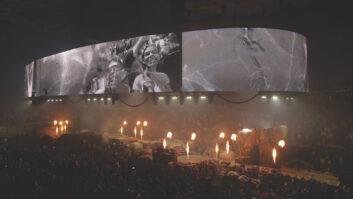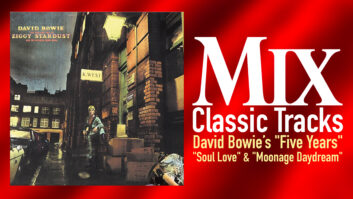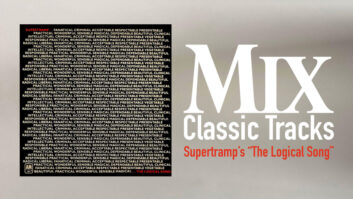Since his first dates as an assistant engineer during The Beatles’ sessions for A Hard Day’s Night at London’s Abbey Road Studios (then known as EMI Studios), Ken Scott has been at the forefront of many key developments in popular music. His work with David Bowie defined a sound known as “glam.” His sessions with fusion pioneers Mahavishnu Orchestra landed him gigs producing many albums with the cream of that movement’s talents.
The experience he gained working with such musically accomplished and compositionally evolved artists enabled Scott to take Supertramp from an unfocused art-pop assemblage to a band capable of producing one of album rock’s most enduring records, Crime of the Century. His affinity for connecting with quirky artists produced fine albums for Devo, theatric rockers Happy the Man and The Tubes. Then, when MTV and ’80s pop were first making a splash, Scott produced 3D, Missing Persons and Level 42, bands with melodic pop smarts and musical chops that were as solid as any fusion ensemble. Through the ’90s, Scott continued producing notable projects, including Dada and their hit “Dizz Knee Land.” More recently, Scott did the 5.1 remix of Bowie’s Ziggy Stardust and worked with George Harrison on the re-release of All Things Must Pass and other Harrison projects.
Your SACD surround remix of Bowie’s classicZiggy Stardust & The Spiders From Marscame out awhile ago. How was the experience revisiting those tracks?
It was an amazing experience, especially going back to Abbey Road to do it, which is where I started. I was working with Paul Hicks, one of the engineers on all of The Beatles re-releases. Because it was a whole new format for me and a new studio — well, kind of a new studio — I thought I should work with someone else. It was an absolute joy.
It was interesting rediscovering things from back then. I would love to know how I got some of the sounds that were on the multitracks; you just can’t get them these days, for whatever reason. [Laughs] And things like how for a long time, orchestras over in England refused to use headphones. So when we were overdubbing orchestras, we had to feed it through speakers to them, which would quite often create problems. I was fascinated, having completely forgotten about that, going back and hearing all of these orchestral tracks and the basic track blasting out of the speakers. But even with things like that, it still sounded great.
Did Bowie have any input on the surround mixes?
No, other than specifying that I had to do it. He was never there for the original mixes, so if he wasn’t there originally, he is certainly not going to be there now when he is so fed up with all of his past work.
I feel that quite a lot of 5.1 [material] is being thought of in much the same way as quad was when that was originally coming out in the ’70s. Record companies think that they can take an album and get it mixed in 5.1 in a couple of days, spend as little money on it as possible and just throw it out there and the general public won’t know the difference. This, of course, is utter bullshit.
Bowie did it the right way: He is reverting back to the people who did it originally, the ones that know the product that well, that knew what was going on back then and how it should sound. We’ve been talking about doing 5.1 on David’s stuff for a couple of years now, and all the way along the line have specified the producer and engineer that did it originally has to do it now, which is the way it should be. Crime of the Century by Supertramp would be the most perfect surround record. But after many phone calls, I discovered it’s been farmed out. Boy, was I disappointed.
When I look at the list of people that you’ve worked with, it seems you’ve always been anticipating trends or developments.
I suppose it comes down to not wanting to become bored. Although there are some technical and artistic areas that I tend to repeat when it comes to the music, I prefer to do something different and hopefully something I haven’t necessarily heard before.
The palette of today’s rock and pop music seems quite narrow these days.
Absolutely. As much as we would bitch at English radio years ago — and the fact that there were only like three stations — the amount of different things played on English radio was phenomenal.
I feel that one of the problems we have today is everything is so defined. If you want to hear R&B, you’ll go to an R&B radio station. If you want to hear something else, you’ll go to another radio station. There’s not that sort of mixture of putting on a radio station and suddenly hearing something completely unexpected that is a completely different style of music you’ve never heard before.
It was much more eclectic on the radio over there back then and that gave people much more varied taste. David [Bowie] always said that he took all of his influences, threw them in a big bowl, mixed it up a little bit and it came out as being Bowie.
I can see that. He seemed equally influenced from artists ranging from Jacques Brel and Anthony Newley to the Velvet Underground.
Right. Now, if the only influences you are getting are one particular type of music, how far can you expand yourself?
Another problem is the prevalence of overly compressed, uniform, in-your-face music that adds to a sameness. I really believe it undermines much of the dynamic ebb and flow that creates real emotional immediacy. Apparent dynamics and real dynamics are not the same thing.
Absolutely, it’s ridiculous. I like dynamics. I hate the compression that’s used these days. It bores me to tears. How has it evolved? I feel that it has devolved. It’s not something that I’m particularly happy about, but it’s just the way it’s gone with technology.
Can you describe your methodology when you mixed a track in analog?
The way I worked for many years was to do a short section at a time. For instance, I’d get the intro right and then go onto the first verse, get that section right, splice it onto the intro and move on to the next section. I used to piece everything together like that and it enabled me to make some drastic changes between sections.
This process evolved from the Bowie sessions. Up to that point, there’d be the producer, myself, a second and quite often an artist, and if we needed to make changes, there would be hands everywhere on the console as we’d go through an entire mix. When it came to mixing Ziggy Stardust and Hunky Dory, it was just me, and quite often there wasn’t even a second. The only way I could do what I wanted was to do it in sections. The knack was having it so the edit didn’t sound like an edit. You had to have the very beginning there, and there had to be enough “hang-over” from the section before to make it sound right so it would all fit together. I would mark everything on the desk and then change it to the way I wanted it to sound. Then I would go back and put it where it had been and quickly I did it — bits and pieces.
I still think that my best work was done that way. These days, with computerized boards — and not necessarily going on to analog — I don’t like it as much.
Do you think that the physicality of printing to analog tape and splicing together sections allowed you to mentally and emotionally change gears and get “outside of the box” more?
Yes, absolutely. I know you can do things in sections with automation, but it just doesn’t feel quite the same way. Mentally, I’m into it in a different way now and I don’t know if I like it.
When mixing in short sections, I found I could really focus and keep my attention on a specific thing — for instance, the bass — through the section and make sure it’s exactly where I want it at all times. I’m afraid that with automation, because one is dealing with much longer sections — normally, the entire song — I seem to suffer with a short attention span and drift around between instruments more. And along with this, I tend to think more in the long — the whole piece — than the short: the intro, verse or whatever. Just a little, but certainly more than I used to.
The Beatles’ fearlessly creative works, Bowie’sZiggy Stardustor Mahavishnu’sBirds of Fire,among others you worked on were groundbreaking. You must have had a strong sense that you were involved in something very special on some level at the time.
Just working with the greatest band in the world [The Beatles] was a complete high, from beginning to end. What more can one ask for? But, generally, I get freaked out when I think about the whole historical thing and how important they actually are. I chose not to think of it that way. I’m very much like George [Harrison] was in that respect. We did some recordings that happened to be very good and people liked them. Period. They [the artists] were doing their jobs and I was there just doing my job. That’s it.
It’s almost blown out of proportion, the way I see it. The whole thing of talking about The Rise and Fall of Ziggy Stardust 30 years after the event is incomprehensible to me. We did something we hoped we might have to talk about for six months. That would’ve meant that it was successful. Over six months, no way.
One aspect that made The Beatles so unique was the fact that many of their recordings had sounds and mixes that were audacious as compared to other recordings of the time, and for that matter, even by today’s standards.
Oh, yeah. It was the ’60s. Rules were meant to be broken. For a period of time on some of those songs, the standard procedure for mixing was full bass and full treble on every track. That was the EQ. One day, probably John came in and said, “Just put full bass and full treble on everything,” and he liked the sound of it and it caught on. Everyone wanted to do that on everything. That was just toward the end of the White Album.
I remember with “Savoy Truffle,” we were mixing it very loud when [Beatles producer] George Martin, who had been on vacation in Greece, walked in and passed a comment to George [Harrison]: “Wow, that’s very bright, isn’t it?” and George said, “Yup, and I like it.” And that’s how it stayed. [Laughs]
One of my favorite tracks from theWhite Albumis “Yer Blues,” which is The Beatles at their rawest.
We were trying a different approach to the recording of one of George’s vocals, and as an aside, I said to John, “I suppose for the next song you’ll want to record in there,” pointing to a very small room adjoining the control room. He jumped on the idea and the next song to be recorded was “Yer Blues.” [Laughs]
For whatever reason, there was a level of unfettered artistry. Maybe before the conglomerates took over the record companies.
I think that has a lot to do with it. The corporations weren’t telling any of us what to do. We were just doing what we wanted to do and, one has to add, it was selling.
Tell me about working with Devo.
It was great. They’re much like The Tubes in that they have this stage persona that makes everyone think they’re totally insane, but when you get close with them, that persona isn’t there and they are very, very clever. They’d do everything they could to make people believe this persona.
One day, we were in the studio and I got a phone call from the studio owner saying, “I’ve got this guy who wants to book some time. Can I show him around?” We weren’t that busy, so I said, “Yeah, sure.” It was a normal business-like session. Sanity prevailed. Then in walks this prospective client. Mark [Mothersbaugh, of Devo] started to sort of run around, completely ridiculous. He almost scared the guy out of the control room by appearing completely manic; that’s the only way I can describe it. He was being very silly. It just went along with the stage persona. As soon as the guy left, we sat down and continued the session as normal. The Tubes were very similar. All business in the studio, but if someone came in, they’d suddenly become one of their many stage personas.
So if you were to look at your sessions, what would you say are some of your greatest Spinal Tap moments?
Oh boy! [Laughs]It’s funny, because the things I remember like that are all me. It’s that kind of thing where you think you’re changing the EQ on something and you suddenly realize the EQ’s not switched in. So all that you’re doing is purely in your imagination: You’re not changing anything, but you’re hearing it change each time.
I’ve done that with trying to select a vocal. I got into the habit of recording like six takes and then I’ll spend an hour or so going through and picking the best bits and making a composite. There’s this one line that I can’t find a good take of and I’m going through and trying different words and all of that. The second [engineer] and I are discussing it, and he’ll say one take is a bit flat and I’ll say a word is right-on. And we’d be going through it when I would realize that I wasn’t changing tracks at all. I was hearing the same track all the time, but we were both hearing it different ways each time we heard it. So I just listened to the whole thing turned up to 11 and it all sounded wonderful. [Laughs]
When it came to Missing Persons, I took on the role of manager, as well as producer and engineer. Even chief cook and bottle washer doesn’t cover everything that job entailed. We were to do a TV show up in the north of England. Well, the tour manager happened to send the wardrobe case full of dirty laundry to the TV studio and took the one with the stage clothes down with him to London. Luckily, Dale [Bozzio], the singer, had a couple of the transparent plastic bowls she needed, but I had to chase all over Manchester or Newcastle trying to find thin plastic tubing to fashion the bowls into the type of almost see-through bra she was renowned for wearing onstage at that time. I never in my wildest dreams pictured me kneeling on the floor of a TV studio, soldering iron in hand, making holes in bowls to be used to support and cover a singer’s breasts.
Almost every one of the things in Spinal Tap I saw at one time or another with them, including getting lost trying to find the stage.
So you had your “Hello, Cleveland” moment.
Oh, absolutely. [Laughs]
One group that did exceptionally fine work with you were the Dixie Dregs. I always thought Steve Morse [Dregs’ lead guitarist] had the technical prowess of John McLaughlin, but he had a strong compositional sense of developing melody. Their second album,What If,is great from top to bottom, but “Night Meets Light” is a particularly gorgeous piece of music.
Absolutely. “Night Meets Light” is definitely my favorite off of there. Steve was probably the best guitarist I’ve ever worked with, but he didn’t have to prove it, whereas McLaughlin always felt he had to. If Steve felt something called for a lot of notes, he’d do that, but if he felt that one note would’ve done for an entire solo, that’s what he would’ve done.
Capricorn Records understood their music and how to sell it. Unfortunately, then Arista signed the band and lost them completely. They had this thing with signing those types of bands and then not knowing what to do with them. Had Capricorn still been around and had the next album, the Dregs could’ve possibly taken over where Mahavishnu left off.
You’ve covered so many different realms as a producer. What attracts you to an artist or band?
I have no idea. Quite frequently, no one quite knows what it is I’m seeing. All I know is that I don’t like to be bored and so I like acts that take you to a lot of different places, and I tend to search for variation on a project-to-project basis. Bottom line, there’s just something deep within me that says, “I wanna work with this. I think that it could happen. I think we could make a really good record.” If it sells, then that’s the icing on the cake.
Rick Clark is Mix’s Nashvilleeditor.
Selected Discography
The Beatles:White Album (1969), Engineer
David Bowie:Hunky Dory (1971), Producer/Engineer
Duran Duran:Pop Trash (2000), Engineer
George Harrison:All Things Must Pass (1970), Engineer
Jeff Beck:There and Back (1980), Producer/Engineer
Kansas:Vinyl Confessions (1982), Producer/Engineer
Level 42:World Machine (1985), Producer/Engineer
Lou Reed:Transformer (1972), Engineer
Mahavishnu Orchestra:Visions of the Emerald Beyond (1974), Producer/Engineer
Procol Harum:Salty Dog (1969), Engineer







